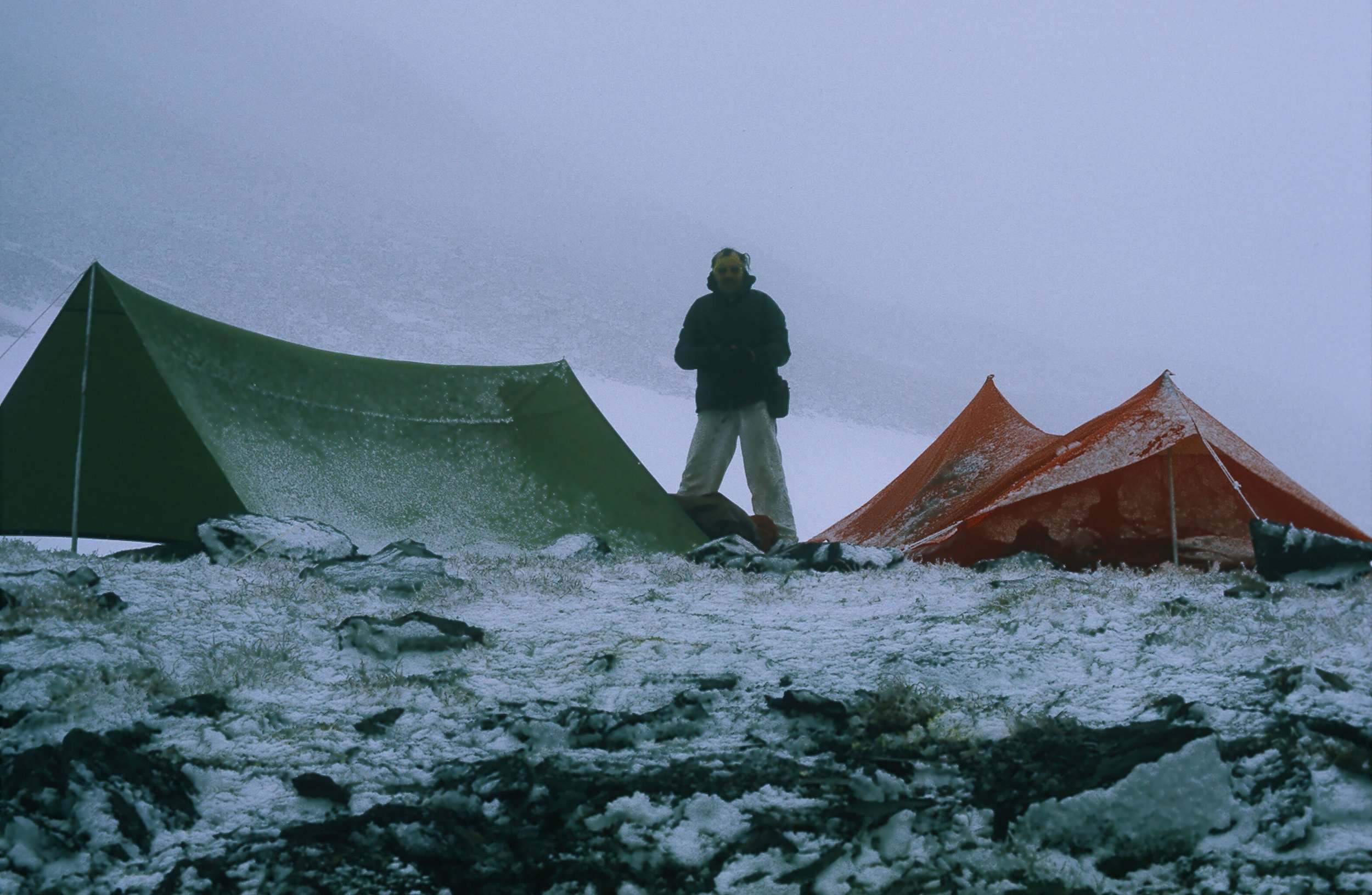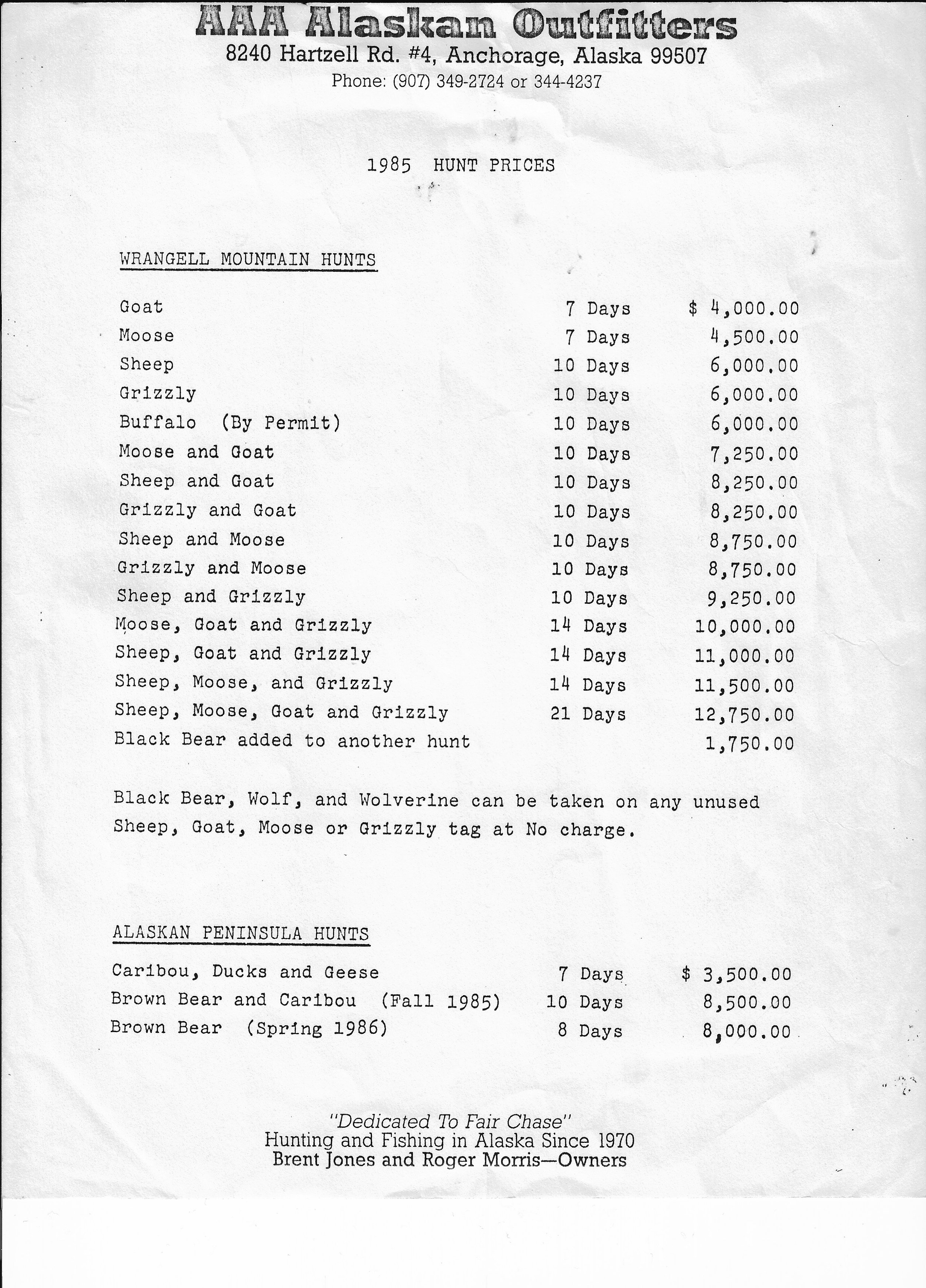There have been many changes in the hunting world over the past 50 years or so, especially in Alaska. Some good and some not so good. I arrived in Anchorage in February 1965 and bought my first resident hunting license in February 1966. It cost $7. I could harvest 1 polar bear, 1 brown bear, 3 black bears, 1 Dall sheep, 2 mountain goats, 1 moose, 3 caribou and 5 black tailed deer each year. No drawings and no tags just general open hunting seasons. The hunting regulations booklet was about 4 x 5 inches in size with about 50 pages. In 1982 it expanded to a 5 ¼ x 8 ¼ booklet with 80 pages. Today it is an 8 x 10 booklet with 144 pages. That’s a lot of regulations.
Spring black bear hunting in 1967. Cotton and G.I. gear.
The population of Alaska in 1965 was 271,000 people and in Anchorage it was around 102,000. Now Alaska’s population is 738,000 and Anchorage is around 291,000. The overall population of hunters makes a big difference in hunting opportunities especially when game populations fluctuate so much because of Alaska’s harsh winters and high predator numbers.
My first ram taken September 6, 1966.
Fall of ‘67.
My friends and I hunted the road system to access Alaska’s game populations and then used “shank’s mare” for the final quest. We hunted sheep, goat, black bear, moose and caribou with fairly high success. I harvested my first Dall ram and my first 40” ram, all six of my goats and two of my black bears using the road system. These hunts were mainly weekend hunts and very inexpensive. That is still possible for most of these animals if you can draw a permit. That’s the hard thing nowadays. One thing you can still do is take a black bear in the Kenai Mountains spotting from the road system during the general hunting season.
One of the Folbots that we used to access road side lakes and rivers. Here we were 3 miles across Trail Lake and 2 miles up Trail River. Then we walked the railroad tracks for a black bear hunt.
After we harvested two black bears on a hillside eight miles down the railroad tracks. On to the Folbot.
One of the first concerns of a hunters is how to access the hunting area. I have always used the cheapest form of transportation whether it be by foot, small boats or small planes. All of these work especially for mountain hunting which has always been my specialty.
The fall of 1967 I did my first fly-in hunt. It cost me and my buddy Gary Wadkins $105 each to fly in to Fog Lakes. We harvested two moose and three caribou. That was one trip in and two trips out in a Cessna 180 on floats. Today that would more than likely cost you $1,000 each or maybe more.
Fog Lakes with two moose and three caribou.
My caribou and moose.
Meat pole on Fog Lakes hunt.
Back at Lake Louise headed to Anchorage in my ‘59 Ford station wagon. Notice the G.I. rain gear.
After that trip we started using a flight service that had a “Widgeon.” It could carry four passengers and light gear, or around a thousand pounds. It was always about the money. Being an enlisted Air Force member with a working wife and two young daughters we had to watch our nickels and dimes. Back then most of my fly-in hunts cost me under $200. Now when we do these type hunts the flying portion costs around $1,000 per person. So that’s a big change.
One of my fly-in caribou hunts on the Alaska Peninsula.
If you have read any of my old stories you know that I hunted in blue jeans, chamois shirts (mainly cotton) and cotton underwear. So, I stayed wet a lot. I used a piece of visqueen for my shelter until I upgraded to a tarp. Most of my other gear was mainly G.I. issue. Back then wool was what most hunters thought was the best type of clothing. Even though it was warm, I personally didn’t like it because it was heavy, scratchy and never dried out.
Me in one of our Visqueen shelters.
Using my green tarp on a sheep hunt.
Things that have changed for the better are clothing and gear. But this has come with a price, i.e., boots. I harvested my first sheep and first goat wearing a cheap pair of rubber boots that cost $2.98 that I purchased at B&J Surplus. After that I started using a good quality leather boot made by Danner which cost around $40 or so. The problem was the leather was too soft and I couldn’t keep the water out of them. As a hard-core sheep hunter, I needed top quality boots so I purchased a top of the line German mountain climbing boot. After I broke them in, they were great, however no matter how I waterproofed them in time, they were going to leak. In the mid 70’s a pair of these boots only cost around $100. Once I started guiding for sheep, I finally bought a pair of plastic mountain climbing boots made by Koflach. I have had two pairs over the last 36 years and have had the soles replaced twice on my current pair. They are the best boots that I have ever used when hunting in the mountains. No blisters and truly waterproof unless you are wading a stream, then you use glacier socks. The last pair cost me $150. Recently, I was pricing top quality boots made in America, Italy and Germany and they are now $400 to $600. Wow, prices have changed!
Hiking out with my sheep on Chitina Glacier in the 70’s.
I think what has changed the most for hunters is clothing. There have been so many different products over the years. It started with Gore-Tex and then polypro. Now there are hundreds of different synthetic fiber materials. It has always been about wicking away moisture and breathable types of materials. They have made some great ones and keep improving constantly. The prices of these products, in my opinion, are through the roof.
Sheep hunting with my grandson Jared back a few years ago.
I will say one thing about rain gear. If it can truly breathe it will eventually leak. Alaska gets more than its share of rain so when it’s really raining, I use the Helly Hansen Impertech long raincoat. If you walk much you will sweat but it will be wicked away by your base layer. I have chosen Microtex, sold at Cabela’s, for my go-to shirt and pants. They are light weight, dry quick, reasonably priced and are warm. I have been using them since around 2000. They have this uncanny quality that when you get blood on them it dries up and falls off. I know that sounds crazy, but it’s true. I use a Berber jacket from Cabela’s with a wind stopper called Windshear. Best coat I have ever owned. I use my hooded one in the late fall. You must use a rain coat but it will keep you warm. Remember, it’s all about layering.
Camo didn’t become popular for hunting until the late 70’s and early 80’s. Now there are so many different patterns it’s hard to count. They have a different pattern for any type of terrain you are hunting in. I have all kinds now but mainly I use the outfitters camo pattern with my Cabela’s gear. If I want to get close for bow hunting sheep or goat, I use whites. They work the best. I know because I have been successful in taking two sheep, one at 20 yards and the other at 25 yards and two goats one at 10 yards and the other at 15 yards. If you want to get close whites are the answer.
My early years of guiding sheep hunters. Kurt Jaeger, Liechtenstein, with a 37” ram.
The guide industry has also changed in many ways especially because of the internet. During my 23 years of guiding, I didn’t book a hunter over the “web” but now I hear they do it all the time. However, what I think has changed the most is the price of hunts. I have made a copy of AAA Alaskan Outfitters 1985 price list. This was the second year of our operation. Brown bear hunts were $8K now they are $30K and Dall sheep hunts were $6K now they’re $25-30K. Of course, moose hunts are right there with them. Guided hunts have always seemed to be a rich person’s sport but it seems even more out of reach for a normal or average person nowadays. But in defense of the high prices, I sure didn’t get rich during my guiding years, mainly because of the high cost of operation.
Me with my largest ram. 40” scoring 167 B&C .
It wouldn’t be fitting if I didn’t talk about sheep hunting in the old days. Populations were good in most areas. Three quarter curls were legal through the 70’s, then they changed to 7/8 curl in the early 80’s. In 1986, I was President of the Alaska Chapter of the Foundation for North American Wild Sheep when Alaska Game Biologist Wayne Heimer came to the Board meeting and asked for our help to finish a sheep study that he had been working on for six years. Then he asked us to support a State wide full curl rule which was already in place in the Tok Management area. He convinced us that if we went to the full curl rule there would always be sheep to hunt. As far as hunting goes, I truly believe that. However, what seems to have happened is the ewe population has crashed in many areas. Take AAA’s Wrangell Mountain area. We started out in 1984 with about 300 or so ewes in the surrounding area and about 40 rams. When I retired in 2005, we had less than 20 ewes in our area and maybe 50 ewes in the surrounding area and around 20 rams. I went back to that area for a hunt on my 70th birthday in 2014 and it was about the same. Our wolf and bear populations had increased which had to take a toll but not that much. It must have been some type of disease that mainly affected the ewes. I have attached a handout from the Alaska Department of Fish & Game showing the harvest of rams from 1967-75 being around 1000+ rams per season. This year the general harvest reported only 352 rams. This doesn’t include the harvest numbers of the permit hunts which I’m guessing to be somewhere over 100 so that is about half of the old day harvest. Something bad is going on. Bad winters, high predator numbers and something else, but it’s not caused by hunting for sure.
This was attached to the sheep harvest tags sometime in the late 70’s early 80’s.
Alaska has changed but it is still a wonderful place to hunt. It costs more no matter how you do it, guided or unguided. Our game populations keep fluctuating but most are in good shape. The Alaska Department of Fish and Game has a handle on most of them. As a resident hunter make your voice heard at the Game Board meetings and as a non-resident hunter make sure you do your research on choosing your guide. Choosing a guide that is a member of APHA is a good start.
Good hunting.
I have had a wonderful 55 years of hunting in my great State of Alaska and hope that my grandchildren will get to enjoy it as much as I have.




















